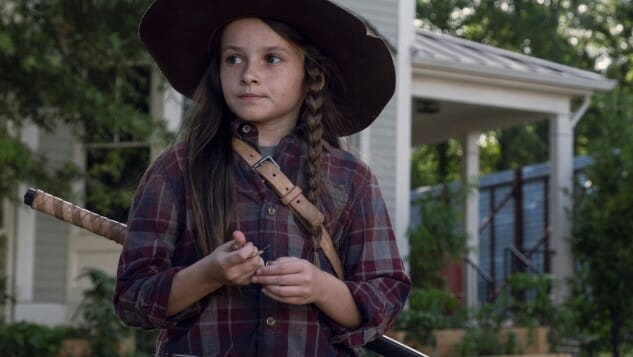The Walking Dead: “Who Are You Now?”
Photos via AMC
![]()
Last week, The Walking Dead snared millions of viewers in a colossal version of what has become the show’s signature move: The bait and switch. For almost a year, we were told that Andrew Lincoln would be departing the AMC series in which he was the de facto main character as Rick Grimes, never to return. For weeks, “Rick Grimes’ last episode” was blared across AMC’s commercial airtime. For 60 minutes, Rick marched grimly toward his very obvious and very noble death. Everything was unfolding as you would expect for a goodbye episode to a primary protagonist after 9 seasons of TV.
… and then AMC pulled the rug out from under everyone, and Rick was helicoptered off into the land of forthcoming TV movies, the scripts of which are still apparently being written. It was some Obi Wan-level dancing around the truth—actually, it’s probably even more of an outright lie for Rick to not die than for Obi Wan to handwave his lies as coming from “a certain point of view.” It left a distinctly sour taste in our mouths, and we weren’t shy about saying so.
Lost in the shuffle of our discontent with “Rick’s last episode,” however, was our simultaneous fascination with the gambit of time-jumping The Walking Dead into the future for a second time in the same season—this time by a whopping six years. It’s a move that allows for sweet little Judith Grimes, a nothing character through almost 7 seasons of TV, to suddenly spring into the forefront. She’s now portrayed by a young actress by the name of Cailey Fleming, who does an admirable job portraying a young girl who has literally never known a life before the zombie apocalypse. She’s at least smart enough to not take Negan’s advice (even on math homework) without a grain of salt, which means that there might just be hope for Judith yet.
The crux of “Who Are You Now?” revolves around a new group of survivors who are brought by Judith to Alexandria: Yumiko, Luke, Connie, Kelly and leader Magna, who immediately earns the ire and suspicion of Michonne for not disclosing everything about her pre-apocalypse self, along with a seeming obsession with hiding weapons on her person. I’d love to ruminate on how these characters might come to fit in amongst the Walking Dead regulars, but we know so little about them at this point that it would be fruitless. Their main purpose in the screenplay is to reinforce just how suspicious and unreasonable Michonne has apparently become in the six years since Rick’s “death.” Her tendency to carry on conversations with Dead Rick and Dead Carl can’t help but remind viewers of Rick in season 3—remember when he was seeing visions of Ghost Lori? Hey folks, remember Lori in general? That woman who didn’t get mentioned at any point in “Rick’s Last Episode?”
Regardless, here are some other things that have changed (or not) in the six year time gap:
— Everyone got aesthetic upgrades. Eugene took off a lot of weight and grew a horrendous looking braid. Carol grew her hair out to absurdly impractical lengths, perhaps to look more “queenly.” Aaron built himself what appears to be a freaking cyborg arm, straight out of Army of Darkness.
-

-

-

-

-

-

-

-

-

-

-

-

-

-

-

-

-

-

-

-

-

-

-

-

-

-

-

-

-

-

-

-

-

-

-

-

-

-

-

-








































